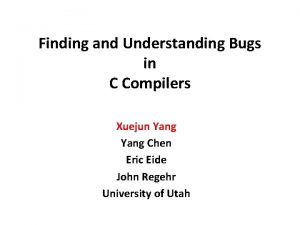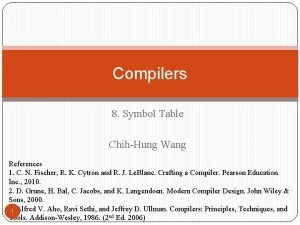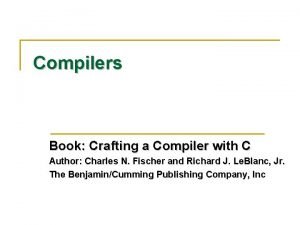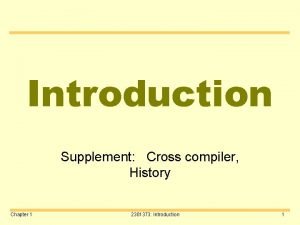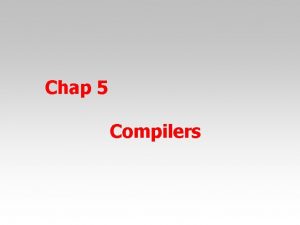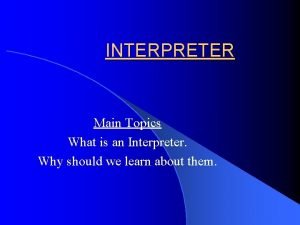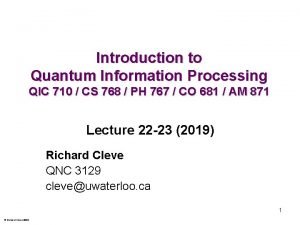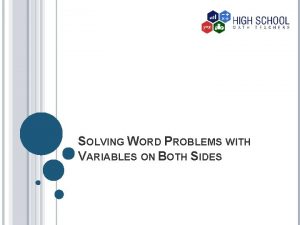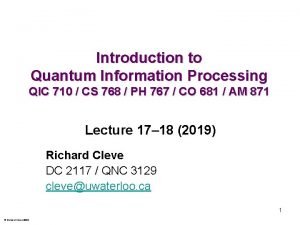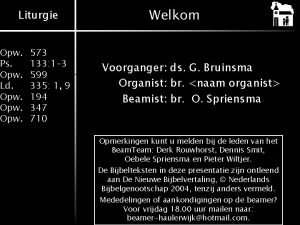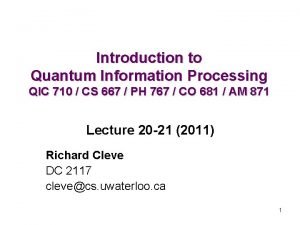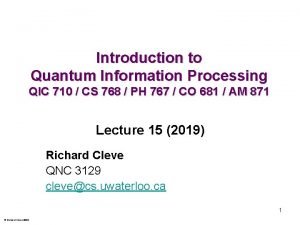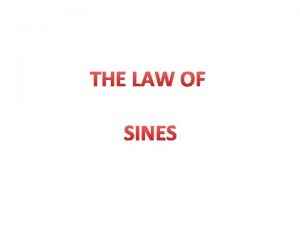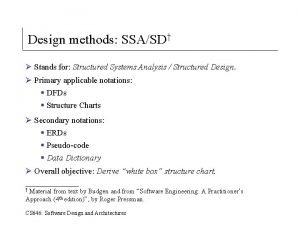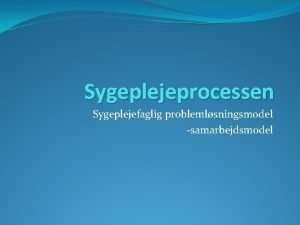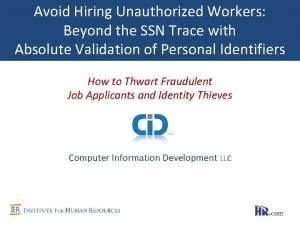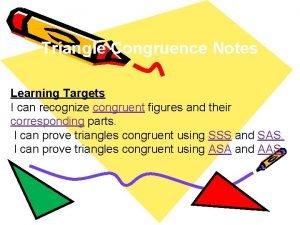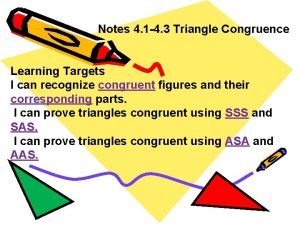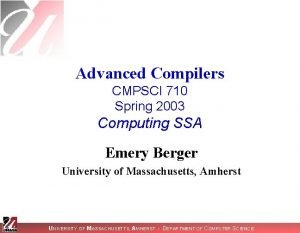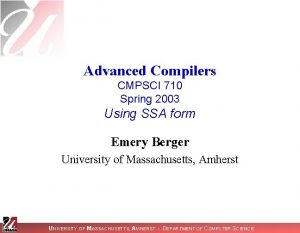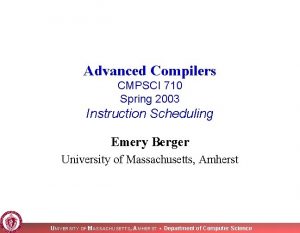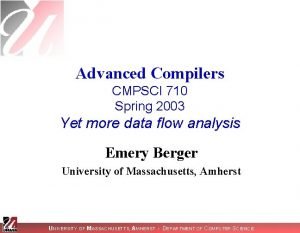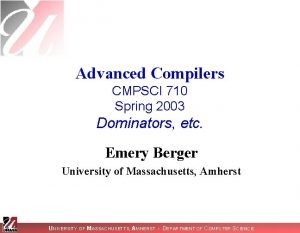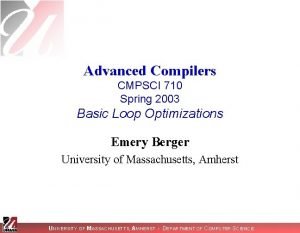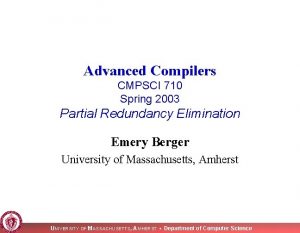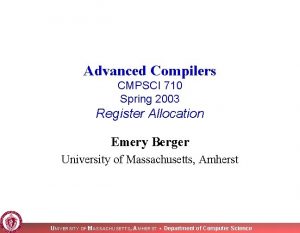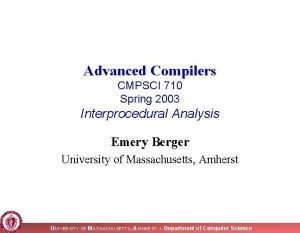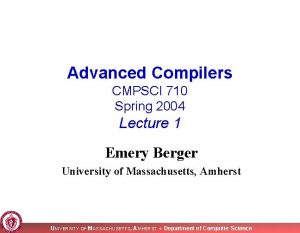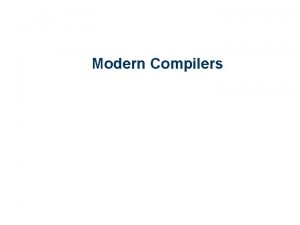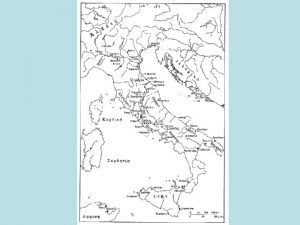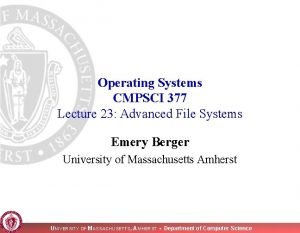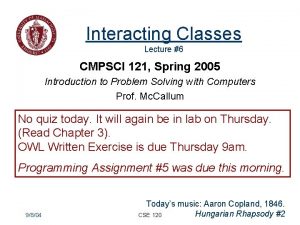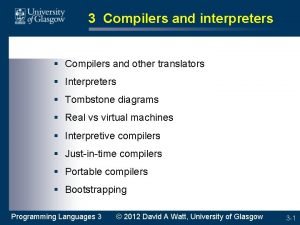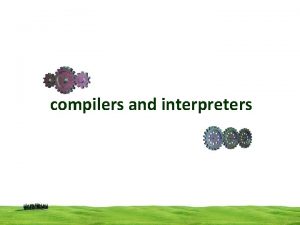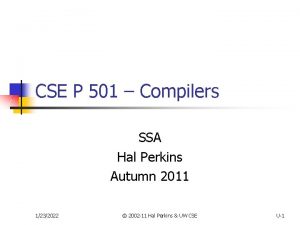Advanced Compilers CMPSCI 710 Spring 2003 Computing SSA



![Path Convergence Criterion [Cytron-Ferrante ‘ 89] Insert function for variable a at node z Path Convergence Criterion [Cytron-Ferrante ‘ 89] Insert function for variable a at node z](https://slidetodoc.com/presentation_image_h2/1d388fbbf57e743a1441bebff8852404/image-4.jpg)

















![Example: Local Dominance Frontier 1 2 3 4 What is DF[5]? 5 6 Remember Example: Local Dominance Frontier 1 2 3 4 What is DF[5]? 5 6 Remember](https://slidetodoc.com/presentation_image_h2/1d388fbbf57e743a1441bebff8852404/image-22.jpg)
![Example: Local Dominance Frontier 1 2 3 4 What is DF[5]? 5 6 Remember Example: Local Dominance Frontier 1 2 3 4 What is DF[5]? 5 6 Remember](https://slidetodoc.com/presentation_image_h2/1d388fbbf57e743a1441bebff8852404/image-23.jpg)









![Shreedar-Gao’s Dominance Frontier Algorithm Dominance. Frontier(x) 0: DF[x] = 1: foreach y Sub. Tree(x) Shreedar-Gao’s Dominance Frontier Algorithm Dominance. Frontier(x) 0: DF[x] = 1: foreach y Sub. Tree(x)](https://slidetodoc.com/presentation_image_h2/1d388fbbf57e743a1441bebff8852404/image-33.jpg)
![Shreedar-Gao’s Dominance Frontier Algorithm Initialization: DF[5] = Dominance. Frontier(x) 0: DF[x] = 1: foreach Shreedar-Gao’s Dominance Frontier Algorithm Initialization: DF[5] = Dominance. Frontier(x) 0: DF[x] = 1: foreach](https://slidetodoc.com/presentation_image_h2/1d388fbbf57e743a1441bebff8852404/image-34.jpg)
![Shreedar-Gao’s Dominance Frontier Algorithm Initialization: DF[5] = Dominance. Frontier(x) 0: DF[x] = 1: foreach Shreedar-Gao’s Dominance Frontier Algorithm Initialization: DF[5] = Dominance. Frontier(x) 0: DF[x] = 1: foreach](https://slidetodoc.com/presentation_image_h2/1d388fbbf57e743a1441bebff8852404/image-35.jpg)
![Shreedar-Gao’s Dominance Frontier Algorithm Initialization: DF[5] = After visiting 6: DF = {4} Dominance. Shreedar-Gao’s Dominance Frontier Algorithm Initialization: DF[5] = After visiting 6: DF = {4} Dominance.](https://slidetodoc.com/presentation_image_h2/1d388fbbf57e743a1441bebff8852404/image-36.jpg)
![Shreedar-Gao’s Dominance Frontier Algorithm Initialization: DF[5] = After visiting 6: DF = {4} After Shreedar-Gao’s Dominance Frontier Algorithm Initialization: DF[5] = After visiting 6: DF = {4} After](https://slidetodoc.com/presentation_image_h2/1d388fbbf57e743a1441bebff8852404/image-37.jpg)
![Shreedar-Gao’s Dominance Frontier Algorithm Dominance. Frontier(x) 0: DF[x] = 1: foreach y Sub. Tree(x) Shreedar-Gao’s Dominance Frontier Algorithm Dominance. Frontier(x) 0: DF[x] = 1: foreach y Sub. Tree(x)](https://slidetodoc.com/presentation_image_h2/1d388fbbf57e743a1441bebff8852404/image-38.jpg)
























- Slides: 62

Advanced Compilers CMPSCI 710 Spring 2003 Computing SSA Emery Berger University of Massachusetts, Amherst UNIVERSITY OF MASSACHUSETTS, AMHERST • DEPARTMENT OF COMPUTER SCIENCE

More SSA n Last time n n n dominance SSA form Today n Computing SSA form UNIVERSITY OF MASSACHUSETTS, AMHERST • DEPARTMENT OF COMPUTER SCIENCE 2

Criteria for Inserting Functions n Brute-force: Insert one function for each variable at every join point (point in CFG with more than one predecessor) n n Wasteful When should we insert function for a variable a at node z of the CFG? n Intuitively: add if there are two definitions of a that can reach the point z through distinct paths UNIVERSITY OF MASSACHUSETTS, AMHERST • DEPARTMENT OF COMPUTER SCIENCE 3
![Path Convergence Criterion CytronFerrante 89 Insert function for variable a at node z Path Convergence Criterion [Cytron-Ferrante ‘ 89] Insert function for variable a at node z](https://slidetodoc.com/presentation_image_h2/1d388fbbf57e743a1441bebff8852404/image-4.jpg)
Path Convergence Criterion [Cytron-Ferrante ‘ 89] Insert function for variable a at node z if all the following conditions are true: 1. There is a block x that defines a 2. There is a block y x that defines a 3. There are non-empty paths x z and y z 4. Paths x z and y z don’t have nodes in common other than z 5. The node z does not appear within both x z and y z prior to the end, but it may appear in one or the other. Note: The start node contains an implicit definition of every variable. UNIVERSITY OF MASSACHUSETTS, AMHERST • DEPARTMENT OF COMPUTER SCIENCE 4

Iterated Path-Convergence Criterion The function itself is a definition of a. Therefore the path-convergence criterion is a set of equations that must be satisfied. while there are nodes x, y, z satisfying conditions 1 -5 and z does not contain a function for a do insert a (a 0, a 1, …, an) at node z This algorithm is extremely costly, because it requires the examination of every triple of nodes x, y, z and every path from x to z and from y to z. Can we do better? UNIVERSITY OF MASSACHUSETTS, AMHERST • DEPARTMENT OF COMPUTER SCIENCE 5

Dominance Reviewed n n Node x dominates node w if every path from the start node to w must go through x Node x strictly dominates node w if x dominates w and x w UNIVERSITY OF MASSACHUSETTS, AMHERST • DEPARTMENT OF COMPUTER SCIENCE 6

Dominance Property of SSA Form n In SSA form, definitions dominate uses: n If x is used in function in block n Ø n If x is used in non- statement in block n Ø n def of x dominates every predecessor of n def of x dominates n The dominance frontier of node x: n nodes w such that x dominates predecessor of w, but x does not strictly dominate w UNIVERSITY OF MASSACHUSETTS, AMHERST • DEPARTMENT OF COMPUTER SCIENCE 7

Example 1 2 3 4 5 6 9 7 8 10 11 12 13 What is the dominance frontier of node 5? UNIVERSITY OF MASSACHUSETTS, AMHERST • DEPARTMENT OF COMPUTER SCIENCE 8

Example 1 2 3 4 5 6 9 7 8 10 11 12 13 First we must find all nodes that node 5 strictly dominates. UNIVERSITY OF MASSACHUSETTS, AMHERST • DEPARTMENT OF COMPUTER SCIENCE 9

Example 1 2 3 4 5 6 9 7 8 10 11 12 13 A node w is in the dominance frontier of node 5 if 5 dominates a predecessor of w, but 5 does not strictly dominate w itself. What is the dominance frontier of 5? UNIVERSITY OF MASSACHUSETTS, AMHERST • DEPARTMENT OF COMPUTER SCIENCE 10

Example 1 2 3 4 5 6 9 7 8 13 10 11 12 DF(5) = {4, 5, 12, 13} A node w is in the dominance frontier of node 5 if 5 dominates a predecessor of w, but 5 does not strictly dominates w itself. What is the dominance frontier of 5? UNIVERSITY OF MASSACHUSETTS, AMHERST • DEPARTMENT OF COMPUTER SCIENCE 11

Dominance Frontier Criterion: If a node x contains a definition of variable a, then any node z in the dominance frontier of x needs a function for a. Can you think of an intuitive explanation for why a node in the dominance frontier of another node must be a join node? UNIVERSITY OF MASSACHUSETTS, AMHERST • DEPARTMENT OF COMPUTER SCIENCE 12

Example 1 2 3 4 5 6 9 7 8 13 10 11 If a node (12) is in the dominance frontier of another node (5), than there must be at least two paths converging to (12). 12 These paths must be non-intersecting, and one of them (5, 7, 12) must contain a node strictly dominated by (5). UNIVERSITY OF MASSACHUSETTS, AMHERST • DEPARTMENT OF COMPUTER SCIENCE 13

Dominator Tree To compute the dominance frontiers, we first compute the dominator tree of the CFG. There is an edge from node x to node y in the dominator tree if node x immediately dominates node y. I. e. , x dominates y x, and x does not dominate any other dominator of y. Dominator trees can be computed using the Lengauer-Tarjan algorithm in O(E (E, N)) time UNIVERSITY OF MASSACHUSETTS, AMHERST • DEPARTMENT OF COMPUTER SCIENCE 14

Example: Dominator Tree 1 2 3 4 5 6 9 7 10 8 Dominator Tree 11 1 12 2 13 Control Flow Graph 4 5 12 3 9 10 6 7 13 11 8 UNIVERSITY OF MASSACHUSETTS, AMHERST • DEPARTMENT OF COMPUTER SCIENCE 15

Local Dominance Frontier Cytron-Ferrante define the local dominance frontier of a node n as: DFlocal[n] = successors of n in the CFG that are not strictly dominated by n UNIVERSITY OF MASSACHUSETTS, AMHERST • DEPARTMENT OF COMPUTER SCIENCE 16

Example: Local Dominance Frontier 1 2 3 4 5 6 9 7 10 8 In the example, what are the local dominance frontiers of nodes 5, 6 and 7? 11 12 DFlocal[5] = DFlocal[6] = {4, 8} DFlocal[7] = {8, 12} 13 Control Flow Graph DFlocal[n] = successors of n in the CFG not strictly dominated by n UNIVERSITY OF MASSACHUSETTS, AMHERST • DEPARTMENT OF COMPUTER SCIENCE 17

Dominance Frontier Inherited From Its Children The dominance frontier of a node n is formed by its local dominance frontier plus nodes that are passed up by the children of n in the dominator tree. The contribution of a node c to its parents’ dominance frontier is defined as [Cytron-Ferrante, 1991]: DFup[c] = nodes in the dominance frontier of c that are not strictly dominated by the immediate dominator of c UNIVERSITY OF MASSACHUSETTS, AMHERST • DEPARTMENT OF COMPUTER SCIENCE 18

Example: Up Dominance Frontier 1 2 3 4 5 6 In the example, what are the contributions of nodes 6, 7, and 8 to its parent dominance frontier? 9 7 10 8 13 Control Flow Graph 11 12 First we compute the DF and immediate dominator of each node: DF[6] = {4, 8}, idom(6)= 5 DF[7] = {8, 12}, idom(7)= 5 DF[8] = {5, 13}, idom(8)= 5 UNIVERSITY OF MASSACHUSETTS, AMHERST • DEPARTMENT OF COMPUTER SCIENCE 19

Example: Up Dominance Frontier 1 2 3 4 5 6 9 7 10 8 13 Control Flow Graph 12 First, we compute the DF and the immediate dominator of each node: DF[6] = {4, 8}, idom(6)= 5 11 DF[7] = {8, 12}, idom(7)= 5 DF[8] = {5, 13}, idom(8)= 5 Now, we check for the DFup condition: DFup[6] = {4} DFup[7] = {12} DFup[8] = {5, 13} DFup[c] = nodes in DF[c] not strictly dominated by idom(c) UNIVERSITY OF MASSACHUSETTS, AMHERST • DEPARTMENT OF COMPUTER SCIENCE 20

Dominance Frontier Inherited From Its Children The dominance frontier of a node n is formed by its local dominance frontier plus nodes that are passed up by the children of n in the dominator tree. Thus the dominance frontier of a node n is defined as [Cytron-Ferrante, 1991]: UNIVERSITY OF MASSACHUSETTS, AMHERST • DEPARTMENT OF COMPUTER SCIENCE 21
![Example Local Dominance Frontier 1 2 3 4 What is DF5 5 6 Remember Example: Local Dominance Frontier 1 2 3 4 What is DF[5]? 5 6 Remember](https://slidetodoc.com/presentation_image_h2/1d388fbbf57e743a1441bebff8852404/image-22.jpg)
Example: Local Dominance Frontier 1 2 3 4 What is DF[5]? 5 6 Remember that: 9 7 10 8 11 12 DFlocal[5] = DFup[6] = {4} DFup[7] = {12} DFup[8] = {5, 13} DTchildren[5] = {6, 7, 8} 13 Control Flow Graph UNIVERSITY OF MASSACHUSETTS, AMHERST • DEPARTMENT OF COMPUTER SCIENCE 22
![Example Local Dominance Frontier 1 2 3 4 What is DF5 5 6 Remember Example: Local Dominance Frontier 1 2 3 4 What is DF[5]? 5 6 Remember](https://slidetodoc.com/presentation_image_h2/1d388fbbf57e743a1441bebff8852404/image-23.jpg)
Example: Local Dominance Frontier 1 2 3 4 What is DF[5]? 5 6 Remember that: 9 7 10 8 11 12 DFlocal[5] = DFup[6] = {4} DFup[7] = {12} DFup[8] = {5, 13} DTchildren[5] = {6, 7, 8} 13 Control Flow Graph Thus, DF[5] = {4, 5, 12, 13} UNIVERSITY OF MASSACHUSETTS, AMHERST • DEPARTMENT OF COMPUTER SCIENCE 23

Computing Dominance Frontiers n Use DFlocal and DFup for X 2 bottom-up traversal of dominance tree DF(X) Ã for Y 2 Succ(X) // local if idom(Y) X then DF(X) Ã DF(X) [ {Y} for Z 2 Children(X) for Y 2 DF(Z) // up if idom(Y) X then DF(X) Ã DF(X) [ {Y} UNIVERSITY OF MASSACHUSETTS, AMHERST • DEPARTMENT OF COMPUTER SCIENCE 24

Join Sets In order to insert -nodes for a variable x that is defined in a set of nodes S={n 1, n 2, …, nk} we need to compute the iterated set of join nodes of S. Given a set of nodes S of a control flow graph G, the set of join nodes of S, J(S), is defined as follows: J(S) ={z G| two paths Pxz and Pyz in G that have z as its first common node, x S and y S} UNIVERSITY OF MASSACHUSETTS, AMHERST • DEPARTMENT OF COMPUTER SCIENCE 25

Iterated Join Sets Because a -node is itself a definition of a variable, once we insert -nodes in the join set of S, we need to find out the join set of S J(S). Thus, Cytron-Ferrante define the iterated join set of a set of nodes S, J+(S), as the limit of the sequence: UNIVERSITY OF MASSACHUSETTS, AMHERST • DEPARTMENT OF COMPUTER SCIENCE 26

Jose Nelson Amaral: nd an example in which IDF of a set S is different Iterated Dominance Frontier rom the DF of the set! We can extend the concept of dominance frontier to define the dominance frontier of a set of nodes as: Now we can define the iterated dominance frontier, DF+(S), of a set of nodes S as the limit of the sequence: UNIVERSITY OF MASSACHUSETTS, AMHERST • DEPARTMENT OF COMPUTER SCIENCE 27

Location of -Nodes Given a variable x that is defined in a set of nodes S={n 1, n 2, …, nk} the set of nodes that must receive -nodes for x is J+(S). An important result proved by Cytron-Ferrante is that: Thus we are really interested in computing the iterated dominance frontier of a set of nodes. UNIVERSITY OF MASSACHUSETTS, AMHERST • DEPARTMENT OF COMPUTER SCIENCE 28

Algorithms to Compute Node Placement The algorithm to insert -nodes, due to Cytron and Ferrante (1991), computes the dominance frontier of each node in the set S before computing the iterated dominance frontier of the set. In the worst case, the combination of the dominance frontier of the sets can be quadratic in the number of nodes in the CFG. Thus, Cytron-Ferrante’s algorithm has a complexity O(N 2). In 1994, Shreedar and Gao proposed a simple, linear algorithm for the insertion of -nodes. UNIVERSITY OF MASSACHUSETTS, AMHERST • DEPARTMENT OF COMPUTER SCIENCE 29

Sreedhar and Gao’s DJ Graph 1 2 3 4 5 6 9 7 10 8 Dominator Tree 11 1 12 2 13 Control Flow Graph 4 5 12 3 9 10 6 7 13 11 8 UNIVERSITY OF MASSACHUSETTS, AMHERST • DEPARTMENT OF COMPUTER SCIENCE 30

Sreedhar and Gao’s DJ Graph 1 2 3 4 D nodes 5 6 9 7 10 8 Dominator Tree 11 1 12 2 13 Control Flow Graph 4 5 12 3 9 10 6 7 13 11 8 UNIVERSITY OF MASSACHUSETTS, AMHERST • DEPARTMENT OF COMPUTER SCIENCE 31

Sreedhar and Gao’s DJ Graph D nodes 1 J nodes 2 3 4 5 6 9 7 10 8 Dominator Tree 11 1 12 2 13 Control Flow Graph 4 5 12 3 9 10 6 7 13 11 8 UNIVERSITY OF MASSACHUSETTS, AMHERST • DEPARTMENT OF COMPUTER SCIENCE 32
![ShreedarGaos Dominance Frontier Algorithm Dominance Frontierx 0 DFx 1 foreach y Sub Treex Shreedar-Gao’s Dominance Frontier Algorithm Dominance. Frontier(x) 0: DF[x] = 1: foreach y Sub. Tree(x)](https://slidetodoc.com/presentation_image_h2/1d388fbbf57e743a1441bebff8852404/image-33.jpg)
Shreedar-Gao’s Dominance Frontier Algorithm Dominance. Frontier(x) 0: DF[x] = 1: foreach y Sub. Tree(x) do 2: if((y z == J-edge) and 3: (z. level x. level)) 4: then DF[x] = DF[x] z 1 2 What is the DF[5]? 4 5 12 3 9 10 6 7 13 11 8 UNIVERSITY OF MASSACHUSETTS, AMHERST • DEPARTMENT OF COMPUTER SCIENCE 33
![ShreedarGaos Dominance Frontier Algorithm Initialization DF5 Dominance Frontierx 0 DFx 1 foreach Shreedar-Gao’s Dominance Frontier Algorithm Initialization: DF[5] = Dominance. Frontier(x) 0: DF[x] = 1: foreach](https://slidetodoc.com/presentation_image_h2/1d388fbbf57e743a1441bebff8852404/image-34.jpg)
Shreedar-Gao’s Dominance Frontier Algorithm Initialization: DF[5] = Dominance. Frontier(x) 0: DF[x] = 1: foreach y Sub. Tree(x) do 2: if((y z == J-edge) and 3: (z. level x. level)) 4: then DF[x] = DF[x] z Sub. Tree(5) = {5, 6, 7, 8} 1 2 4 5 12 3 9 10 6 7 13 11 8 UNIVERSITY OF MASSACHUSETTS, AMHERST • DEPARTMENT OF COMPUTER SCIENCE 34
![ShreedarGaos Dominance Frontier Algorithm Initialization DF5 Dominance Frontierx 0 DFx 1 foreach Shreedar-Gao’s Dominance Frontier Algorithm Initialization: DF[5] = Dominance. Frontier(x) 0: DF[x] = 1: foreach](https://slidetodoc.com/presentation_image_h2/1d388fbbf57e743a1441bebff8852404/image-35.jpg)
Shreedar-Gao’s Dominance Frontier Algorithm Initialization: DF[5] = Dominance. Frontier(x) 0: DF[x] = 1: foreach y Sub. Tree(x) do 2: if((y z == J-edge) and 3: (z. level x. level)) 4: then DF[x] = DF[x] z 1 Sub. Tree(5) = {5, 6, 7, 8} 2 There are three edges originating in 5: {5 6, 5 7, 5 8} but they are all D-edges 3 4 5 12 9 10 6 7 13 11 8 UNIVERSITY OF MASSACHUSETTS, AMHERST • DEPARTMENT OF COMPUTER SCIENCE 35
![ShreedarGaos Dominance Frontier Algorithm Initialization DF5 After visiting 6 DF 4 Dominance Shreedar-Gao’s Dominance Frontier Algorithm Initialization: DF[5] = After visiting 6: DF = {4} Dominance.](https://slidetodoc.com/presentation_image_h2/1d388fbbf57e743a1441bebff8852404/image-36.jpg)
Shreedar-Gao’s Dominance Frontier Algorithm Initialization: DF[5] = After visiting 6: DF = {4} Dominance. Frontier(x) 0: DF[x] = 1: foreach y Sub. Tree(x) do 2: if((y z == J-edge) and 3: (z. level x. level)) 4: then DF[x] = DF[x] z 1 Sub. Tree(5) = {5, 6, 7, 8} 2 There are two edges originating in 6: {6 4, 6 8} but 8. level > 5. level 3 4 5 12 9 10 6 7 13 11 8 UNIVERSITY OF MASSACHUSETTS, AMHERST • DEPARTMENT OF COMPUTER SCIENCE 36
![ShreedarGaos Dominance Frontier Algorithm Initialization DF5 After visiting 6 DF 4 After Shreedar-Gao’s Dominance Frontier Algorithm Initialization: DF[5] = After visiting 6: DF = {4} After](https://slidetodoc.com/presentation_image_h2/1d388fbbf57e743a1441bebff8852404/image-37.jpg)
Shreedar-Gao’s Dominance Frontier Algorithm Initialization: DF[5] = After visiting 6: DF = {4} After visiting 7: DF = {4, 12} Dominance. Frontier(x) 0: DF[x] = 1: foreach y Sub. Tree(x) do 2: if((y z == J-edge) and 3: (z. level x. level)) 4: then DF[x] = DF[x] z 1 Sub. Tree(5) = {5, 6, 7, 8} 2 There are two edges originating in 7: {7 8, 7 12} again 8. level > 5. level 3 4 5 12 9 10 6 7 13 11 8 UNIVERSITY OF MASSACHUSETTS, AMHERST • DEPARTMENT OF COMPUTER SCIENCE 37
![ShreedarGaos Dominance Frontier Algorithm Dominance Frontierx 0 DFx 1 foreach y Sub Treex Shreedar-Gao’s Dominance Frontier Algorithm Dominance. Frontier(x) 0: DF[x] = 1: foreach y Sub. Tree(x)](https://slidetodoc.com/presentation_image_h2/1d388fbbf57e743a1441bebff8852404/image-38.jpg)
Shreedar-Gao’s Dominance Frontier Algorithm Dominance. Frontier(x) 0: DF[x] = 1: foreach y Sub. Tree(x) do 2: if((y z == J-edge) and 3: (z. level x. level)) 4: then DF[x] = DF[x] z Initialization: DF[5] = After visiting 6: DF = {4} After visiting 7: DF = {4, 12} After visiting 8: DF = {4, 12, 5, 13} 1 Sub. Tree(5) = {5, 6, 7, 8} 2 There are two edges originating in 8: {8 5, 8 13} both satisfy cond. in steps 2 -3 3 4 5 12 9 10 6 7 13 11 8 UNIVERSITY OF MASSACHUSETTS, AMHERST • DEPARTMENT OF COMPUTER SCIENCE 38

Shreedhar-Gao’s -Node Insertion Algorithm Using the D-J graph, Shreedhar and Gao propose a linear time algorithm to compute the iterated dominance frontier of a set of nodes. A important intuition in Shreedhar-Gao’s algorithm is: If two nodes x and y are in S, and y is an ancestor of x in the dominator tree, than if we compute DF[x] first, we do not need to recompute it when computing DF[y]. UNIVERSITY OF MASSACHUSETTS, AMHERST • DEPARTMENT OF COMPUTER SCIENCE 39

Shreedhar-Gao’s -Node Insertion Algorithm Shreedhar-Gao’s algorithm also use a work list of nodes hashed by their level in the dominator tree and a visited flag to avoid visiting the same node more than once. The basic operation of the algorithm is similar to their dominance frontier algorithm, but it requires a careful implementation to deliver the linear time complexity. UNIVERSITY OF MASSACHUSETTS, AMHERST • DEPARTMENT OF COMPUTER SCIENCE 40

Dead-Code Elimination in SSA Form Only one definition for each variable ) if the list of uses of the variable is empty, definition is dead When a statement v x y is eliminated because v is dead, this statement must be removed from the list of uses of x and y, which might cause those definitions to become dead. Thus we need to iterate the dead code elimination algorithm. UNIVERSITY OF MASSACHUSETTS, AMHERST • DEPARTMENT OF COMPUTER SCIENCE 41

Simple Constant Propagation in SSA If there is a statement v c, where c is a constant, then all uses of v can be replaced for c. A function of the form v (c 1, c 2, …, cn) where all ci are identical can be replaced for v c. Using a work list algorithm in a program in SSA form, we can perform constant propagation in linear time In the next slide we assume that x, y, z are variables and a, b, c are constants. UNIVERSITY OF MASSACHUSETTS, AMHERST • DEPARTMENT OF COMPUTER SCIENCE 42

Linear Time Optimizations in SSA form Copy propagation: The statement x (y) or the statement x y can be deleted and y can substitute every use of x. Constant folding: If we have the statement x a b, we can evaluate c a b at compile time and replace the statement for x c Constant conditions: The conditional if a < b goto L 1 else L 2 can be replaced for goto L 1 or goto L 2, according to the compile time evaluation of a < b, and the CFG, use lists, adjust accordingly Unreachable Code: eliminate unreachable blocks. UNIVERSITY OF MASSACHUSETTS, AMHERST • DEPARTMENT OF COMPUTER SCIENCE 43

Next Time n Implementing other optimizations with SSA UNIVERSITY OF MASSACHUSETTS, AMHERST • DEPARTMENT OF COMPUTER SCIENCE 44

Single Assignment Form i=1; j=1; k=0; while(k<100) { if(j<20) { j=i; k=k+1; } else { j=k; k=k+2; } } return j; } B 1 i 1 j 1 k 0 B 2 B 3 if j<20 B 5 j i k k+1 if k<100 return j B 4 B 6 j k k k+2 B 7 UNIVERSITY OF MASSACHUSETTS, AMHERST • DEPARTMENT OF COMPUTER SCIENCE 45

Single Assignment Form i=1; j=1; k=0; while(k<100) { if(j<20) { j=i; k=k+1; } else { j=k; k=k+2; } } return j; } B 1 i 1 j 1 k 1 0 B 2 B 3 if j<20 B 5 j i k 3 k+1 if k<100 return j B 4 B 6 j k k 5 k+2 B 7 UNIVERSITY OF MASSACHUSETTS, AMHERST • DEPARTMENT OF COMPUTER SCIENCE 46

Single Assignment Form i=1; j=1; k=0; while(k<100) { if(j<20) { j=i; k=k+1; } else { j=k; k=k+2; } } return j; } B 1 i 1 j 1 k 1 0 B 2 if k<100 B 3 if j<20 B 5 j i k 3 k+1 B 7 return j B 4 B 6 j k k 5 k+2 k 4 (k 3, k 5) UNIVERSITY OF MASSACHUSETTS, AMHERST • DEPARTMENT OF COMPUTER SCIENCE 47

Single Assignment Form i=1; j=1; k=0; while(k<100) { if(j<20) { j=i; k=k+1; } else { j=k; k=k+2; } } return j; } B 1 i 1 j 1 k 1 0 B 2 k 2 (k 4, k 1) if k<100 B 3 if j<20 B 5 j i k 3 k+1 B 7 return j B 4 B 6 j k k 5 k+2 k 4 (k 3, k 5) UNIVERSITY OF MASSACHUSETTS, AMHERST • DEPARTMENT OF COMPUTER SCIENCE 48

Single Assignment Form i=1; j=1; k=0; while(k<100) { if(j<20) { j=i; k=k+1; } else { j=k; k=k+2; } } return j; } B 1 i 1 j 1 k 1 0 B 2 k 2 (k 4, k 1) if k 2<100 B 3 if j<20 B 5 j i k 3 k 2+1 B 7 return j B 4 B 6 j k k 5 k 2+2 k 4 (k 3, k 5) UNIVERSITY OF MASSACHUSETTS, AMHERST • DEPARTMENT OF COMPUTER SCIENCE 49

Single Assignment Form i=1; j=1; k=0; while(k<100) { if(j<20) { j=i; k=k+1; } else { j=k; k=k+2; } } return j; } B 1 i 1 1 j 1 1 k 1 0 B 2 j 2 (j 4, j 1) k 2 (k 4, k 1) if k 2<100 B 3 if j 2<20 B 5 j 3 i 1 k 3 k 2+1 return j 2 B 4 B 6 j 5 k 2 k 5 k 2+2 B 7 j 4 (j 3, j 5) k 4 (k 3, k 5) UNIVERSITY OF MASSACHUSETTS, AMHERST • DEPARTMENT OF COMPUTER SCIENCE 50

Example: Constant Propagation B 1 i 1 1 j 1 1 k 1 0 B 2 j 2 (j 4, j 1) k 2 (k 4, k 1) if k 2<100 B 3 if j 2<20 B 5 j 3 i 1 k 3 k 2+1 return j 2 B 4 B 6 j 5 k 2 k 5 k 2+2 B 7 j 4 (j 3, j 5) k 4 (k 3, k 5) B 1 i 1 1 j 1 1 k 1 0 B 2 j 2 (j 4, 1) k 2 (k 4, 0) if k 2<100 B 3 if j 2<20 B 5 j 3 1 k 3 k 2+1 return j 2 B 4 B 6 j 5 k 2 k 5 k 2+2 B 7 j 4 (j 3, j 5) k 4 (k 3, k 5) UNIVERSITY OF MASSACHUSETTS, AMHERST • DEPARTMENT OF COMPUTER SCIENCE 51

Example: Dead-code Elimination B 1 i 1 1 j 1 1 k 1 0 B 2 j 2 (j 4, 1) k 2 (k 4, 0) if k 2<100 B 3 if j 2<20 B 5 j 3 1 k 3 k 2+1 return j 2 B 4 B 6 j 5 k 2 k 5 k 2+2 B 7 j 4 (j 3, j 5) k 4 (k 3, k 5) UNIVERSITY OF MASSACHUSETTS, AMHERST • DEPARTMENT OF COMPUTER SCIENCE 52

Constant Propagation and Dead Code Elimination B 2 j 2 (j 4, 1) k 2 (k 4, 0) if k 2<100 B 3 if j 2<20 B 5 j 3 1 k 3 k 2+1 return j 2 B 4 B 6 j 5 k 2 k 5 k 2+2 B 7 j 4 (j 3, j 5) k 4 (k 3, k 5) B 2 j 2 (j 4, 1) k 2 (k 4, 0) if k 2<100 B 3 if j 2<20 B 5 j 3 1 k 3 k 2+1 return j 2 B 4 B 6 j 5 k 2 k 5 k 2+2 B 7 j 4 (1, j 5) k 4 (k 3, k 5) UNIVERSITY OF MASSACHUSETTS, AMHERST • DEPARTMENT OF COMPUTER SCIENCE 53

Example: Is this the end? B 2 j 2 (j 4, 1) k 2 (k 4, 0) if k 2<100 B 3 if j 2<20 B 5 k 3 k 2+1 return j 2 B 4 B 6 j 5 k 2 k 5 k 2+2 B 7 j 4 (1, j 5) k 4 (k 3, k 5) But block 6 is never executed! How can we find this out, and simplify the program? SSA conditional constant propagation finds the least fixed point for the program and allows further elimination of dead code. UNIVERSITY OF MASSACHUSETTS, AMHERST • DEPARTMENT OF COMPUTER SCIENCE 54

Example: Dead code elimination B 2 j 2 (j 4, 1) k 2 (k 4, 0) if k 2<100 B 3 if j 2<20 B 5 k 3 k 2+1 B 6 j 5 k 2 k 5 k 2+2 B 7 j 4 (1, j 5) k 4 (k 3, k 5) return j 2 B 4 B 5 k 3 k 2+1 B 7 j 4 (1) k 4 (k 3) UNIVERSITY OF MASSACHUSETTS, AMHERST • DEPARTMENT OF COMPUTER SCIENCE 55

Example: Single Argument Function Elimination B 2 j 2 (j 4, 1) k 2 (k 4, 0) if k 2<100 return j 2 B 4 B 5 k 3 k 2+1 B 7 j 4 (1) k 4 (k 3) return j 2 B 4 B 5 k 3 k 2+1 B 7 j 4 1 k 4 k 3 UNIVERSITY OF MASSACHUSETTS, AMHERST • DEPARTMENT OF COMPUTER SCIENCE 56

Example: Constant and Copy Propagation B 2 j 2 (j 4, 1) k 2 (k 4, 0) if k 2<100 B 2 j 2 (1, 1) k 2 (k 3, 0) if k 2<100 return j 2 B 4 B 5 k 3 k 2+1 B 7 j 4 1 k 4 k 3 UNIVERSITY OF MASSACHUSETTS, AMHERST • DEPARTMENT OF COMPUTER SCIENCE 57

Example: Dead Code Elimination B 2 j 2 (1, 1) k 2 (k 3, 0) if k 2<100 return j 2 B 4 B 5 k 3 k 2+1 B 7 j 4 1 k 4 k 3 UNIVERSITY OF MASSACHUSETTS, AMHERST • DEPARTMENT OF COMPUTER SCIENCE 58

Example: -Function Simplification B 2 j 2 (1, 1) k 2 (k 3, 0) if k 2<100 B 2 j 2 1 k 2 (k 3, 0) if k 2<100 return j 2 B 4 B 5 k 3 k 2+1 UNIVERSITY OF MASSACHUSETTS, AMHERST • DEPARTMENT OF COMPUTER SCIENCE 59

Example: Constant Propagation B 2 j 2 1 k 2 (k 3, 0) if k 2<100 return j 2 B 4 B 5 k 3 k 2+1 return 1 B 4 B 5 k 3 k 2+1 UNIVERSITY OF MASSACHUSETTS, AMHERST • DEPARTMENT OF COMPUTER SCIENCE 60

Example: Dead Code Elimination B 2 j 2 1 k 2 (k 3, 0) if k 2<100 return 1 B 4 B 5 k 3 k 2+1 UNIVERSITY OF MASSACHUSETTS, AMHERST • DEPARTMENT OF COMPUTER SCIENCE 61

Next Time UNIVERSITY OF MASSACHUSETTS, AMHERST • DEPARTMENT OF COMPUTER SCIENCE 62
 Giduk
Giduk Front end and back end in compiler design
Front end and back end in compiler design Cs 421 programming languages and compilers
Cs 421 programming languages and compilers Finding and understanding bugs in c compilers
Finding and understanding bugs in c compilers Yacc symbol table
Yacc symbol table Binarymove compilers
Binarymove compilers Crafting a compiler
Crafting a compiler Advantages and disadvantages of compiler and interpreter
Advantages and disadvantages of compiler and interpreter Cousins of compiler
Cousins of compiler Basic compiler functions in system software
Basic compiler functions in system software Cs 421 programming languages and compilers
Cs 421 programming languages and compilers What is an interpreter
What is an interpreter Months that are in spring
Months that are in spring Understanding standards advanced higher computing
Understanding standards advanced higher computing Conventional computing and intelligent computing
Conventional computing and intelligent computing Euperlan pco
Euperlan pco A gas has a pressure of 710 kpa at 227
A gas has a pressure of 710 kpa at 227 Qic710
Qic710 Vde 0100 700
Vde 0100 700 Pedro opened his account with $710
Pedro opened his account with $710 Qic 710
Qic 710 699 en yakın yüzlüğe yuvarlama
699 en yakın yüzlüğe yuvarlama Opwekking 573 tekst
Opwekking 573 tekst Da pam 710-2-1
Da pam 710-2-1 Ar 710-2-2
Ar 710-2-2 Ortec 710
Ortec 710 Qic 710
Qic 710 Qic 710
Qic 710 Ivano dones
Ivano dones Dott ssa benilde cosmi bologna
Dott ssa benilde cosmi bologna Federal benefit unit
Federal benefit unit Nom 030 ssa 2009
Nom 030 ssa 2009 Law of sines ssa
Law of sines ssa Silvia consorti
Silvia consorti Ssasd
Ssasd Dott ssa übersetzung
Dott ssa übersetzung Dott ssa alessandra muliere
Dott ssa alessandra muliere Fireside chats apush
Fireside chats apush Komponen aas
Komponen aas Adjektivkomposita
Adjektivkomposita Ssa afsluttende projekt eksempel
Ssa afsluttende projekt eksempel Praktikmål ssa
Praktikmål ssa Ssa network
Ssa network Farmakologi opgave ssa
Farmakologi opgave ssa Sygeplejeprocessen identifikationsfasen
Sygeplejeprocessen identifikationsfasen Ssa
Ssa Staatliches schulamt ludwigsburg
Staatliches schulamt ludwigsburg Ambiguous case trigonometry
Ambiguous case trigonometry Sss sas asa aas
Sss sas asa aas Monika hengge
Monika hengge Cbsv ssa-89 - personal information
Cbsv ssa-89 - personal information Role of ssa in universalisation of elementary education
Role of ssa in universalisation of elementary education Ssa processo de ingresso
Ssa processo de ingresso Dott ssa übersetzung
Dott ssa übersetzung Ssa suisse
Ssa suisse Amato pediatra
Amato pediatra Vertical angles
Vertical angles Monika hengge
Monika hengge Sarva shiksha abhiyan punjab
Sarva shiksha abhiyan punjab Congruence postulate
Congruence postulate Aas theorem
Aas theorem Cbltdli
Cbltdli Ssa math
Ssa math



